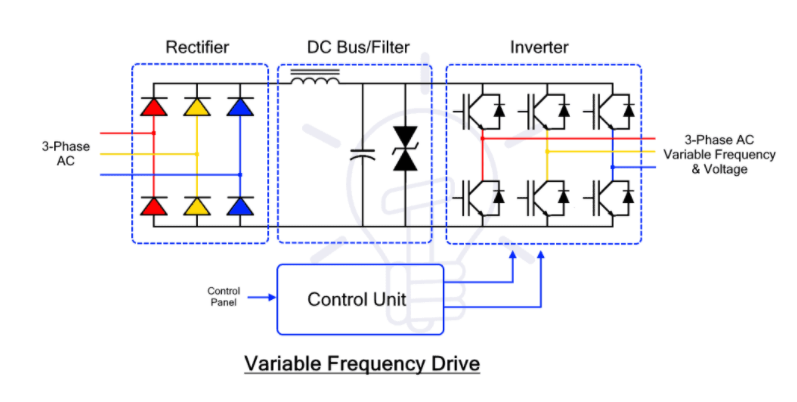What is a VFD?
Variable frequency drives/ variable speed drives/ VFD/ VSD are all one and the same. They are used to control the speed of rotation of a motor by regulating the frequency and voltage of the electric motor’s input power supply. The speed of the motor can be controlled precisely using a variable frequency drive.
What is the main section of VFD?
Variable Frequency Drives are motor controller devices used in numeral applications, from small appliances to large compressors, and much more in between! The main function of the VFD is to drive and control motor speed and torque to meet application requirements by varying supply voltage and frequency.
What are the components of a VFD?
A VFD is comprised of three main components: A Rectifier, a DC link, and an Inverter. The rectifier converts the AC supply into DC power. The DC Link supports voltage through the drive from the rectifier and inverter, the DC link stores power converted by the rectifier

How does a variable frequency drive work?
A variable frequency drive comprises a rectifier, filters, an inverter, switching, and control circuits. Input to the VFD is usually a three-phase AC supply. This three-phase input supply is rectified and converted into DC voltage by the rectifier. This DC voltage is again converted into a Three-phase AC voltage of required frequency and threshold by the inverter.
What are the different types of loads?
There are two types of loads: Constant torque load and variable torque load.
Constant torque loads: The load torque characteristic does not depend on the speed. The load torque remains approximately the same over the whole speed area.
Variable or quadratic Torque loads: The load torque is proportional to the square of the speed and power increases as the cube of speed.
Impact loads: These loads demand intermittent torque. Example: Punch press.
List out few constant torque applications:
· cranes
· elevators
· ski lifts
· escalators
· and conveyors
List out few variable torque applications:
· Pumps
· Fan
Constant torque curve vs Variable torque curve
VFD application Areas
1.1 Petroleum:
oil transfer pump, electric submersible pump, injection pump, oil pumping unit, etc.
1.2 Chemical industry:
Extruder Machine, film conveyors, mixers, compressors, blowers, sprayers, pumps, etc.
1.3 Steel:
rolling mill, roller table, fan, pump, crane, ladle car, converter tilting, etc.
1.4 Metallurgical industry:
rolling mill, roller table, blast furnace fan, pump, hoisting machinery, blast furnace feeding, steel mill polishing, etc.
1.5 Electricity:
Blowers for boiler drums, feed pumps, centrifugal mixers, conveyor belts, pumping power stations, flywheels, etc.
1.6 Mining:
mud pumps, conveyor belts, hoists, cutting machines, excavators, cranes, blowers, pumps, compressors, etc.
1.7 Cement:
rotary kiln, hoisting machinery, blower, pump, main drive motor, conveyor belt, shaft kiln fan, etc.
1.8 Paper industry:
paper machines, pumps, pulverizers, fans, mixers, blowers, etc.
How to choose a suitable VFD for a motor?
1 Voltage
First, select the appropriate voltage, there are single-phase 220V, three-phase 220V, three-phase 380V (to 480V).
2 Current
Choose according to the rated current of the motor. The rated output current of the inverter cannot be lower than the rated current of the motor. Select the same for light load, and increase one power for heavy load.
3 Working Conditions
If the inverter needs to run with a long cable, we should suppress the influence of the long cable on the coupling capacitance to avoid insufficient output of the inverter. Therefore, in this case, the capacity of the inverter should be increased by one power or put an output reactor at the output end of the inverter.
If interference exists in the working environment, filters will be considered.
Advantages of VFD
VFD not only provides variable speed control but also offers energy saving with improved efficiency and simple control. Here are some of the advantages or benefits of VFD
Improved Efficiency: The conventional speed control using the variable voltage method wastes a lot of energy as compared to the variable frequency method. Therefore, VFD is used in industries to increase motor efficiency and conserve a great amount of energy.
Precise Control: A VFD allows tighter control of the speed using a sensor to run the motor at an efficient speed that does not cause hindrance and increases the production speed in the industries.
Limits Inrush Current: Inrush current is the huge starting current drawn by an induction motor during its startup. it is 5 to 8 times greater than its rated current. It can damage the windings of the motor. The VFD can safely limit the starting current and it is used in one of the methods for induction motor starting.
Extend Mechanical Life: It can safely start and stop a motor with a gradual change in speed without any mechanical jerks. It extends the mechanical life of the motor.
Reduced Maintenance: Smooth operation of motors reduces the mechanical stress and eliminates the jerks that eventually reduce the maintenance required for such motor. Thus reducing the long-term cost.
Power Factor: A poor power factor causes reactive power loss that is the energy wasted in the form of heat. Induction motor usually has a low power factor. A VFD improves the power factor to utilize the power more efficiently.
Protection: A VFD can also provide protection against overload, over-voltage and phase loss. It immediately stops the supply current in case of such faults to protect the load connected from damage.
Easy installation: They are easier to install and operate since they are programmed during manufacturing with easy to operate and friendly user interface.
Get real-time quotes
Interested? Leave your contact details.

